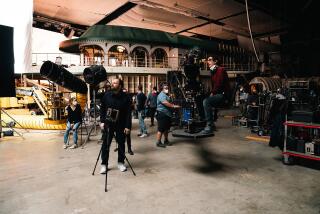Digitals Vs. Opticals in Film Special Effects
- Share via
In “Movie Magic” (Jan. 31), Peter Kuran, the owner of VCE, a “special effects and color restoration firm,” states that “Anyone who does optical work and doesn’t deal with digital has absolutely no work any more.”
That’s interesting. We’ve been listening to the digital and computer gurus saying this for years, as if by proclaiming opticals dead the optical houses will simply take their quality, cost-effective, high-resolution special effects and disappear.
Sure, some optical houses have left the scene, but so have many small digital operations; Hollywood is littered with the fragments of small companies. But those optical houses I am familiar with seem to be cranking out films as always, doing feature films for major players.
In addition, since “Demon Knight” played in theaters, I’d like to know how they finally output the digital images onto film, a very expensive process, and the actual resolution of those images--some of the questions that won’t go away and must be asked.
Although it could be said that I am skeptical out of self-interest and fear, as I have been known to use optical printers to create special effects, I wouldn’t mind using new technology to create motion pictures provided the quality and resolution are there. I love any wedding of technology that enhances the final image and makes the creation of films less expensive.
If and when film goes by the wayside as the preferred medium for the creation, storage and presentation of motion pictures, then optical houses, film-to-film laboratories and theaters, as we currently think of them, will be history.
But until that time, I challenge any company or person to convince me that it’s cheaper, quicker and of higher quality to scan an image from film to computer bits, manipulate that data and output back onto film, than to manipulate film directly, creating the effects within the medium in which it will finally be presented.
More complex effects are often easier to composite in a digital arena. However, show me a “meat and potatoes” optical--a fade, dissolve or three-image montage--which is not made more complicated and expensive by the conversion process, and I’ll eat my beret.
Certainly, digital effects are excellent and can often attain new creative levels, but let’s not let the profiteers of the new technology dictate what looks best on the screen. The death of optical effects has been promised by digital effects companies for decades, and I am sure the day will come when the prophets see their rosy vision materialize over the hills of Hollywood. However, I hope that the output of that digital vision is clearly equal or superior to that obtained by current analog technology.
ANTHONY MUNROE
Los Angeles
More to Read
The biggest entertainment stories
Get our big stories about Hollywood, film, television, music, arts, culture and more right in your inbox as soon as they publish.
You may occasionally receive promotional content from the Los Angeles Times.










